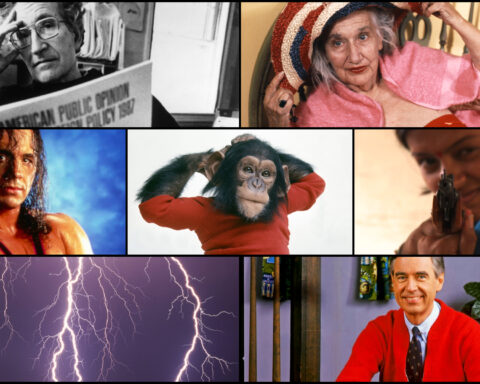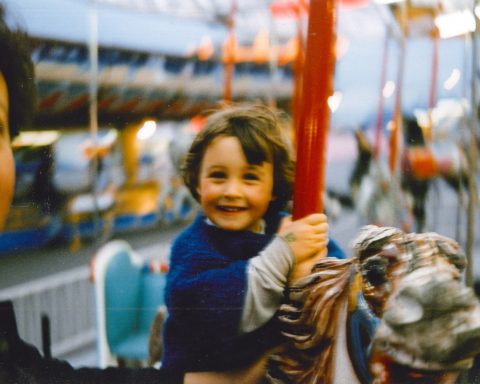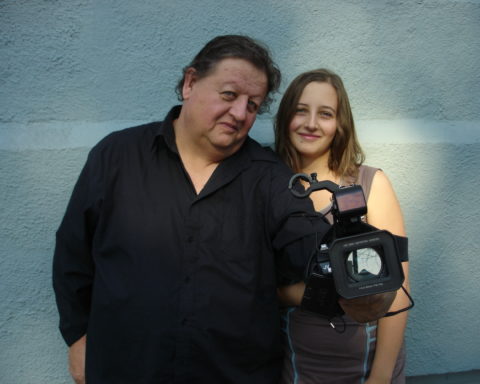UNKEMPT, YET WEARING A TUXEDO JACKET, leaning against a kitchen sink. That’s the image that lingers from the first time I laid eyes on Peter Wintonick. It was a crowded film festival house party in Toronto in the early ’80s. Who could forget that big, friendly Ukrainian face? He punctuated the din with a series of contentious pronouncements about the state of film, the state of the world, the state of the party. Aloof, cryptic, he’d let loose a little smile between comments. I didn’t know what to make of him.
Peter had been building a career as a coveted editor of fiction feature films. But after completing Your Ticket Is No Longer Valid, something snapped. He chose to “take a vow of poverty,” as he liked to say, and apply his talents full time to documentary.
At roughly the same time, after the involuntary end of a stint on the family TV drama series Danger Bay, I had similarly vowed henceforth to work only on projects that really meant something to me.
That’s when I re-encountered Peter in his newfound role of filmmaker-activist. But this time we had something in common. He was in Toronto recruiting support for one of our filmmaking heroes Peter Watkins’ anti nuclear, anti-mainstream-media film, The Journey (1986). Many of us would work for years on that film with little or no pay, subsidizing the project by ensuring our subsistence in other ways. Peter supervised the post-production at the National Film Board of Canada (NFB) in Montreal, and despite his and others’ best efforts to rein in the production, its director kept making it longer, eventually letting the film grow to an unwieldy 14 ½ hours, which, combined with its didactic tone and snail-paced editing, doomed it to a miniscule audience.
Frustrated by that experience, but also bonded by it, in 1987 Peter and I were ready to take on a project of our own. I had already started developing a film with some friends in Toronto about the world-renowned linguist and radical political analyst, Noam Chomsky. But it soon became apparent that it was not an ideal partnership. I made the difficult decision to part ways and seek a more suitable collaboration. Peter was my number one choice, and it took nothing more than a kitchen table chat over a bottle of scotch for us to decide to proceed together on the film that would become Manufacturing Consent: Noam Chomsky and the Media. We thought it might take a couple of years to finance and complete. It would take five.
It was a deeply satisfying collaboration. Our skills, values and whatever-works aesthetic meshed effortlessly. Confronting an intellect like Chomsky’s, we were sufficiently humbled to keep our egos out of the way. We didn’t take ourselves too seriously, but were determined to try and do justice to Chomsky’s genius and dark humour, using a wide range of film techniques to engage viewers. Our approach was obsessive yet playful, and we enabled each other to flourish creatively. It was the ideas that mattered, not who had them.
We co-directed in the field, following Chomsky everywhere we could afford to on his global speaking tours. At one point Chomsky commented that if we weren’t there to greet him coming off the plane, he thought he’d arrived in the wrong place. We often didn’t have the budget to transport and pay for professional technical assistance, so we filled those positions ourselves, trading roles as necessary, as camera operator or sound recordist, shooting with whatever gear we could get our hands on. We both did interviews. Back home in the bowels of the NFB, as researchers tracked down archival material, Peter focused more and more on editing. I continued directing, shooting or animating more sequences with the help of many dedicated collaborators, among them Francis Miquet, who would eventually continue on as Peter’s producing partner at Necessary Illusions.
I had huge respect for Peter’s talent. Watching him cut Manufacturing Consent was like watching a virtuoso jazz musician play an instrument called a “Steenbeck”—the ubiquitous brand of flatbed film editing machines. Stopping on a frame of 16mm film and marking it with a grease pencil, a casual flick of his wrist could appear flippant, but invariably, it was intuitively calculated, building just the right rhythm for every shot and scene.
Peter laid out the meta-structure of the film early on, with dozens of little Post-it notes on a board. Not unlike If You Love This Planet, it was essentially an illustrated lecture, with a beginning, middle and end. But we had multiple beginnings, multiple middles and multiple ends, all of which Peter shuffled deftly. The editing was made harder by Chomsky’s detailed digressions and parenthetical comments, but it was made easier in other ways. The intelligence of Chomsky’s utterances was so engaging and his delivery so remarkably consistent through the years, Peter could begin a sentence in 1968 and finish it in 1990 and you’d barely notice the edit.
Peter’s poetic nature balanced my more literal approach. I can remember one serious late-night disagreement, over a point that Chomsky made which I felt was edited with extraneous flourishes that confused more than they clarified. Peter would be completely open to discussing any cut, and was fine when I occasionally took reels off to another room to work on a scene if I wanted to try an alternative approach. He wasn’t attached, and never cited the depth of his editing experience as a source of authority. When I showed him the simplified scene, he made a joke out of it, saying, “Well, why didn’t you just say so in the first place?” Whatever worked best is what made it into the film. We were blessed with a shared sense of what worked best.
Nothing was too absurd to try, if we thought it might bring home a point. Outtakes may exist, somewhere, of Peter and me dressed as futuristic hucksters peddling sets of “Philosopher All-Star Trading Cards” (our own invention), including one of Noam Chomsky, designed to quickly convey a history of famous anarchists and revolutionary thinkers. It was a dreadfully executed idea, and only the cards themselves made it into the film; certainly not our low-budget, sci-fi depictions. What’s precious to me is that we didn’t censor ourselves before giving it a go and we cracked each other up in the process.
We worked together, ate together and partied together. People would call us Mutt and Jeff. In case you’re unfamiliar, Mutt and Jeff was the world’s first newspaper comic strip, created in 1907. One tall, one short, always scheming, and inseparable. Mutt was a fanatic horse-race gambler, Jeff an inmate of an insane asylum. Peter and I were arguably a bit of both. We played for high stakes, madly risking years of our lives on long-shot, one-off film projects.
Today, when I watch Manufacturing Consent, the quality of our collaboration is still palpable. We managed to combine having fun with doing something important. Some filmmakers feel compromised if anyone other than themselves influences their creative process. Not us. Even with lengthy rough cuts, it seemed natural to consult test audiences as often as possible. More than 600 people contributed: friends, classrooms full of students, film festival audiences, intimate focus groups. They filled out questionnaires and were encouraged to be critical. We wanted to be sure we were connecting with viewers from beginning to end before locking picture. Remarkably, the consensus was that 167 minutes was not a problem. We added an intermission anyway, to be safe. This not only allowed theatres to sell more popcorn, but seat neighbours to discuss the film in progress, and activists to distribute literature. To our repeated delight, theatrical screenings of the film built community and activated dissent.
We travelled the world making and promoting Manufacturing Consent. The global network of Chomsky’s supporters supported us, with food, shelter, footage and contacts. A case study in the film helped publicize the plight of East Timor, and at the commercial premiere in Australia, we were ceremonially lauded by the Timorese for telling their story. After Peter’s death, in an on-stage interview with DOC NYC aired by Democracy Now, Chomsky praised Peter and our work, especially the “evocative and imaginative” presentation of the East Timor story, which he said, “maybe saved a lot of lives.”
Manufacturing Consent: Noam Chomsky and the Media would eventually receive 22 awards and honours, play theatrically in over 300 cities—setting box office records for a Canadian documentary—and be seen by television audiences around the world. A large part of its success is due to the tireless grassroots outreach efforts of Peter’s partner, Christine Burt, who worked in conjunction with a vast network of volunteers, and a financially-empowered, creative marketing team at the NFB. To this day, the film is a staple in an astonishingly broad range of academic courses.
After Manufacturing Consent had proven itself critically and commercially, CBC called. They had rejected the film in its proposal stage, offering no development support (unlike VisionTV), but now wanted to show it in their prime time documentary slot, Witness. The radical content was all fine and “journalistically defensible,” as they put it, but there was just one problem: the length. “We’d love to show your 167-minute film,” the Witness producer said, “if you’ll cut 124 minutes.” She was apparently serious. I wondered aloud if she recalled the “concision” section in the film, which demonstrated how mainstream TV systematically excludes unconventional analyses by imposing extreme time constraints.
We ended up cutting a 90-minute version for CBC (the shortest to air anywhere) to play in a two-hour slot, with 30 minutes of commercials. Peter and I relished the irony of so many commercials interrupting our film, critical as it is of the many problems created by profit-driven media. So we produced two commercials of our own, for the Manufacturing Consent VHS and my companion book to the film. We cast ourselves in our no-budget ads, mimicking fast-talking owner-on-the-lot car dealership commercials, complete with a 1-800 number, and paid CBC for the airtime.
The film’s success caught me off guard. Public speaking and broadcast interviews churned my stomach. Like many filmmakers, I’m much happier behind the camera. But Peter relished the spotlight, or at least was indifferent to it, and I happily conceded it to him when I could. When I couldn’t, I would ask him to rehearse with me, plan things out, decide who’d say what. Not a chance. “Relax,” he’d say, “it’s all ephemeral anyway.” Peter applied that philosophy to all aspects of his life. I just wish he hadn’t gone to such an extreme to prove the truth of it.
I’d have loved to have worked with Peter again. In 1997, UBC law professor Joel Bakan and I initiated The Corporation (2003) and on more than one occasion, I invited Peter to work with us. But in the time it took me to complete the companion book to Manufacturing Consent, move to Vancouver and get going on The Corporation, Peter had long since moved on: editing other films; nurturing young talent; guiding new projects; growing audiences and developing new media. At one point, Peter became an advisor on media policy to the Adelaide provincial government in Australia. He loved handing out business cards bearing his official title, “Thinker In Residence”.
Documentary filmmakers occasionally approach me for advice on how to get their films off the ground, wondering who to talk to, which broadcasters, commissioning editors or programming strands; which funders, distributors, festivals… Never feeling I really had the big picture, the answer used to be easy: “Just talk to Peter Wintonick.” With his globe-circling travels and bulging Rolodex, Peter had a unique overview of the machinations of the documentary world. In supporting the next generation of filmmakers, it will take a concerted collective effort to even begin to reconstruct the insights he so easily and generously shared.











